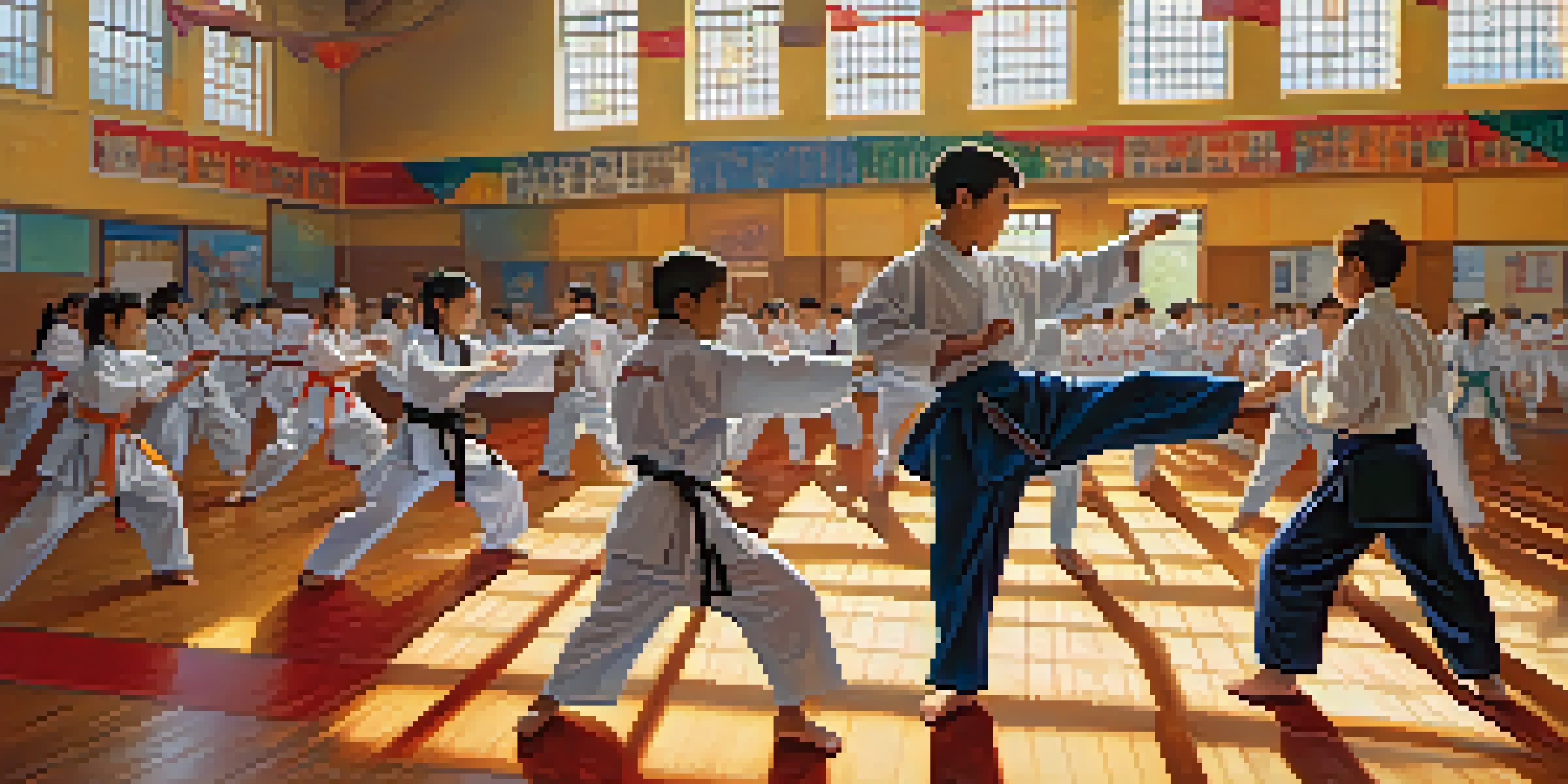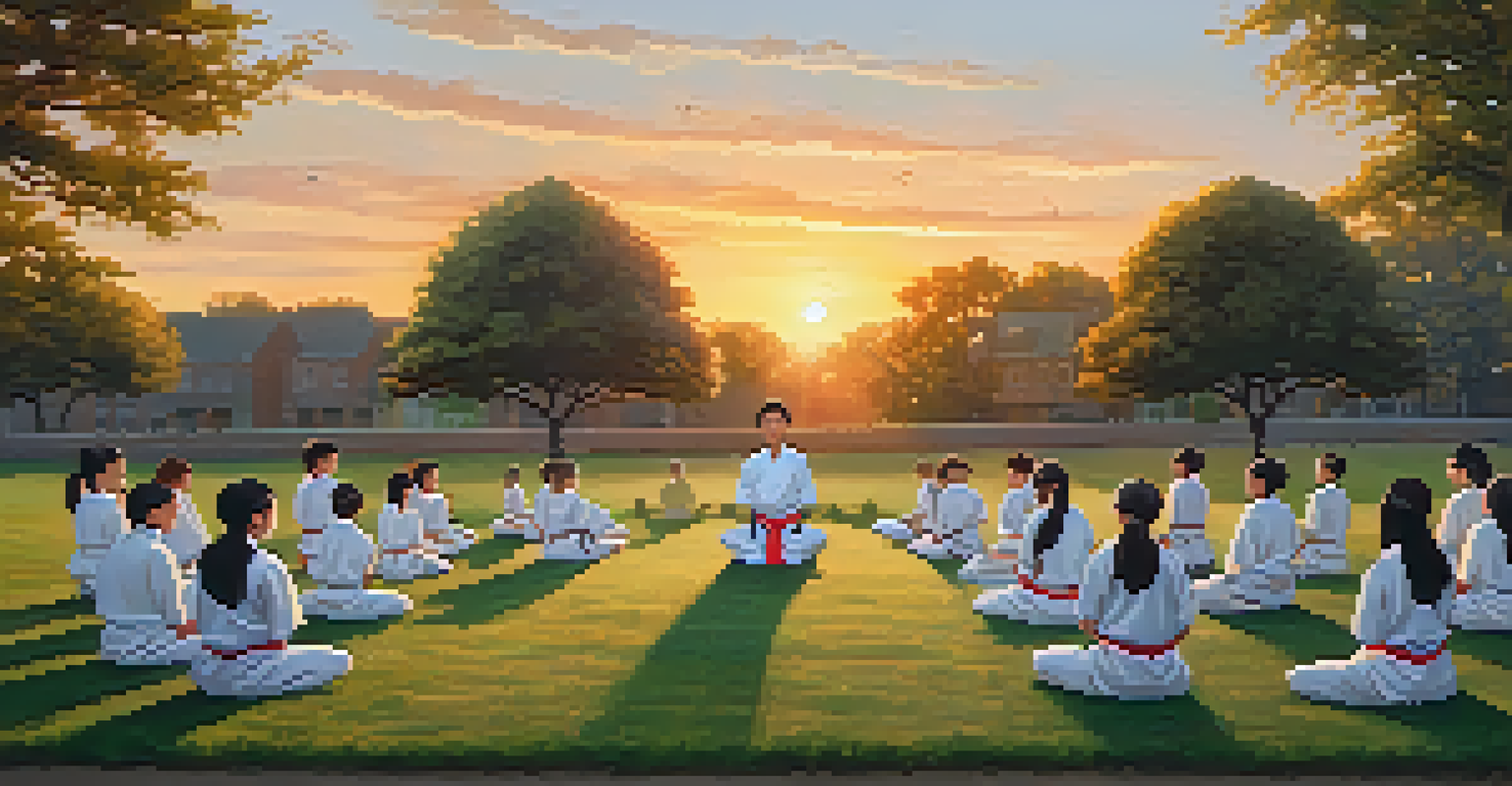Martial Arts Programs in Schools and Their Health Benefits

Introduction to Martial Arts in School Programs
Martial arts programs in schools have been gaining popularity in recent years. These programs not only teach self-defense techniques but also instill discipline and respect among students. Schools are increasingly recognizing the value of incorporating martial arts into their physical education curriculum to enhance students' overall development.
Martial arts is not about fighting; it’s about building character and resilience.
By introducing martial arts, schools provide students with a structured environment to learn important life skills. These skills include focus, perseverance, and the ability to work as part of a team. Furthermore, martial arts can cater to students of all ages and skill levels, making it an inclusive option for diverse school populations.
As more schools adopt these programs, they are seeing positive changes in student behavior and engagement. This shift not only benefits the students involved but also creates a more harmonious school atmosphere overall.
Physical Health Benefits of Martial Arts
One of the most significant advantages of martial arts is its impact on physical health. Engaging in martial arts training helps students improve their cardiovascular fitness, flexibility, and strength. These physical benefits contribute to a more active lifestyle, encouraging students to stay fit and healthy.

Moreover, martial arts promote coordination and balance, which are essential skills in any physical activity. The dynamic movements involved in martial arts help students develop agility and reflexes, making them more physically adept. As students advance in their training, they also learn about the importance of proper nutrition and overall wellness.
Holistic Benefits of Martial Arts
Martial arts programs enhance students' physical health, mental well-being, and social skills, fostering overall development.
Incorporating martial arts into school programs can lead to a noticeable decrease in obesity rates among students. This proactive approach to physical health paves the way for lifelong habits that prioritize fitness and well-being.
Mental Health Benefits of Martial Arts
The mental health benefits of martial arts are equally impressive. Practicing martial arts can significantly reduce stress and anxiety levels in students. The focus required during training allows students to channel their energy productively, creating a sense of calm and clarity.
The greatest victory is that which requires no battle.
Additionally, martial arts instill a sense of confidence and self-esteem in practitioners. As students learn new techniques and achieve their goals, they gain a sense of accomplishment that translates into other areas of their lives. This boost in self-confidence can lead to better academic performance and social interactions.
Furthermore, martial arts teach valuable coping strategies for dealing with life's challenges. Students learn how to stay composed under pressure and how to approach problems with a clear mind, equipping them with essential skills for future success.
Social Benefits of Martial Arts in Schools
Martial arts programs foster a sense of community and camaraderie among students. When students train together, they build friendships and learn to work collaboratively towards common goals. This social aspect of martial arts nurtures teamwork and communication skills that are vital in both personal and professional settings.
Moreover, martial arts classes often emphasize respect for others, promoting a positive school culture. Students learn to appreciate diversity and support one another, creating a more inclusive environment. This respect extends beyond the dojo, fostering a culture of kindness and understanding within the school.
Discipline and Goal Setting
Training in martial arts instills discipline and a goal-oriented mindset, benefiting students in academics and personal growth.
As students engage in martial arts, they also develop valuable conflict resolution skills. Instead of resorting to violence, they learn to communicate effectively and resolve disputes peacefully, which is crucial for maintaining harmony within the school community.
Building Discipline Through Martial Arts
Discipline is a core component of martial arts training. Students are taught the importance of dedication, focus, and hard work from the very beginning. This structured approach helps instill a strong work ethic that can benefit students in all aspects of their lives.
Through regular practice and progression through belt ranks, students learn to set goals and work towards achieving them. This goal-oriented mindset is essential for academic success and personal growth. The discipline learned in martial arts can also translate into improved study habits and time management skills.
As students experience the rewards of their efforts in martial arts, they become more motivated to apply the same discipline to their studies and extracurricular activities. This holistic approach to discipline contributes to well-rounded individuals who are prepared for future challenges.
Safety and Self-Defense Skills
An important aspect of martial arts is the emphasis on safety and self-defense. Students learn how to protect themselves while also understanding the importance of conflict avoidance. This knowledge can empower students and provide them with the skills to handle potentially dangerous situations calmly and effectively.
Self-defense training teaches students to assess situations critically and make informed decisions. Instead of resorting to aggression, martial arts encourages them to find peaceful resolutions first. This approach not only promotes personal safety but also fosters a culture of respect and understanding.
Empowerment Through Self-Defense
Learning self-defense in martial arts empowers students with the skills to handle challenges calmly and safely.
Additionally, knowing self-defense can boost students' confidence in navigating their environments. This newfound sense of security can alleviate fears and anxieties, allowing them to focus on their studies and personal development without unnecessary distractions.
Conclusion: The Value of Martial Arts in Education
In conclusion, martial arts programs in schools offer a multitude of health benefits that go beyond physical fitness. From enhancing mental well-being to promoting social skills, the impact of martial arts is profound and far-reaching. By investing in these programs, schools can cultivate healthier, more disciplined, and well-rounded students.
The integration of martial arts into education systems aligns with the growing emphasis on holistic development. As more schools recognize the importance of physical and mental health, martial arts programs can play a crucial role in shaping students' futures. This investment not only benefits individual students but also contributes to a positive school environment.

Ultimately, martial arts programs are not just about learning self-defense; they are about developing life skills that empower students to thrive. By fostering a culture of respect, discipline, and community, schools can help students become the best versions of themselves.